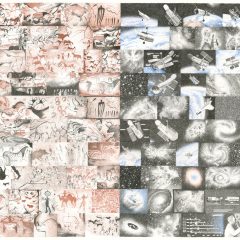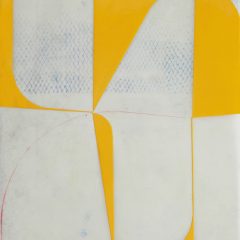
Ink Blot Drawing, 12/26/1996
Ink on paper
21 7/8 x 16 ½ inches
image provided by Gallery Joe
What is Bruce Conner doing in an exhibit with Jacob El Hanani and Mark Lombardi? I ask myself, as I walk into Gallery Joe.
Conner, who is in his 70s, is a trickster of an artist, a guy who likes to play games of all sorts with the art world–like refusing to sign his pieces and then telling his gallerist to forge the signature. He’s the guy whose “Bombhead,” an exploding head above a military jacket, was in the Big Nothing at the ICA. According to Wikipedia, my favorite source of superficial information and misinformation, Conner, unhappy with his gallery contract, “reacted by attending openings, only to move among the crowd worldlessly pinning buttons that read ‘I am Bruce Conner’ or ‘I am not Bruce Conner’ to their clothes.”
(I can totally relate to that, Roberta and I having asked two young women to wear nametags reading Libby and Roberta for one of our giveaways.)

Ink Blot Drawing, 2/17/1999
Ink on paper
23 1/16 x 29 inches
image provided by Gallery Joe
But there at Gallery Joe, Conner’s work hangs, looking positively decorous, especially if you don’t pay attention to the suggested body parts that the carefully controlled, blots appear to represent. The meticulous folding and attention to scale communicate a celebration of the transcendent in the physical world, of the miraculous way we are symmetrical and love symmetry.

Mark Lombardi
Roberto Calvi, Banco Ambrosiano, Michele Sindona and the Vatican Bank
aka IOR (2nd version), 1996
Graphite on paper
22 x 30 inches
image provided by Gallery Joe
I have to say that even after all these years, Mark Lombardi’s trackings of political and financial scandals still look like constellations. The visuals, sometimes worked over, sometimes less so, also suggest cosmoses.

Grid Gauze, 2001-02, Ink on paper
6 1/16 x 9 ¾ (image)
10 7/8 x 14 ½ (sheet)
image provided by Gallery Joe
And El Hanani, whose work I continue to admire, dances with his pen on the head of a pin–another path to the divine–his nearly microscopic lines and circles pushing the surface back until the marks float on air. To El Hanani, I have to deliver the golden magnifying glass award, although he and Randall Sellers might have to fight over it. (I wonder how El Hanani’s eyes are holding up.)
The black-and-white practice of all three artists is deceptive. While for Lombardi, the diagrams were an attempt not only to express outrage but to bring into control a world that was out of control, in both El Hanani’s and Conner’s practice, the control on the paper is deceptive–it’s their path to loss of control that leads them somewhere far, far away.









